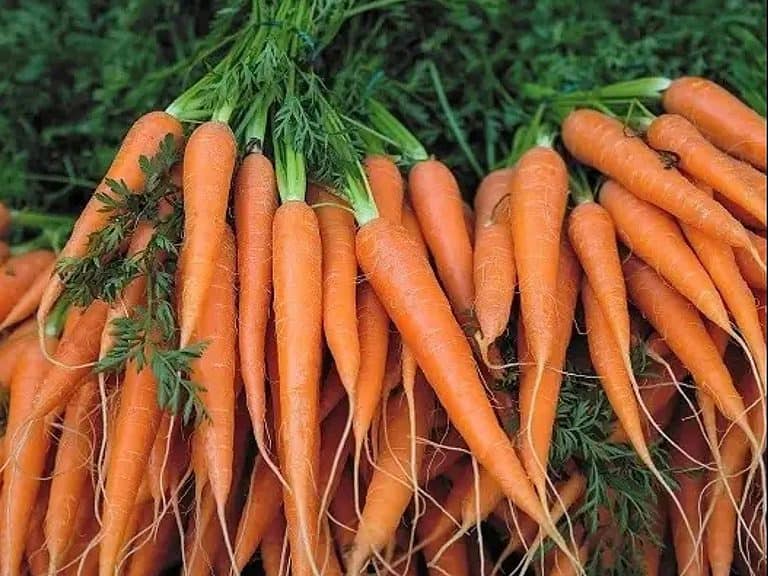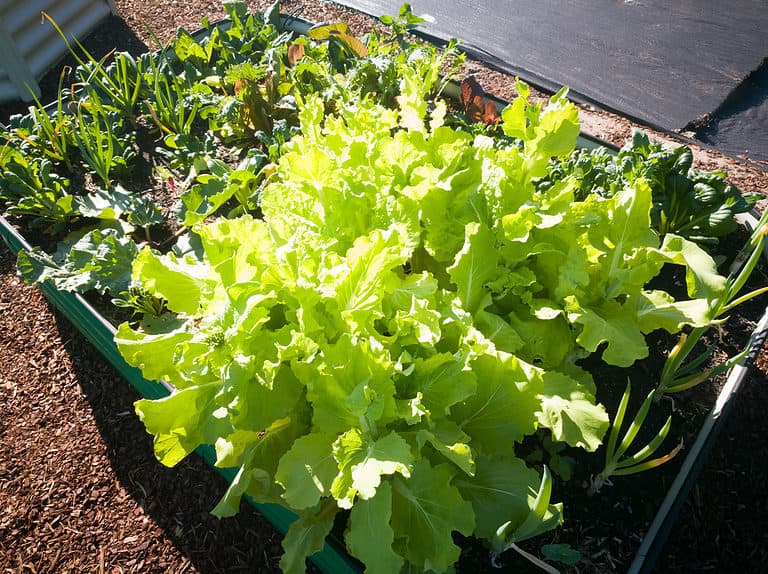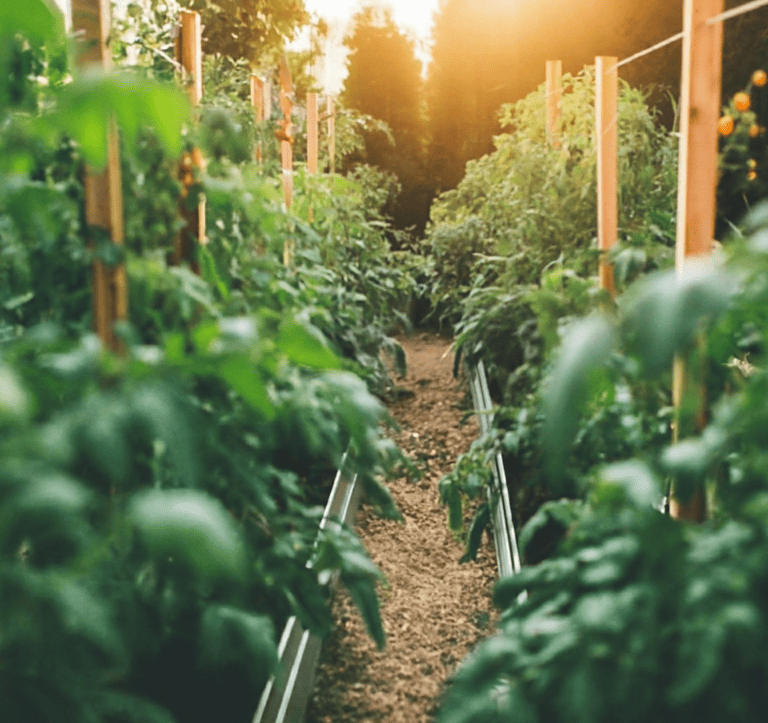Top Tips for Effective Companion Planting in Your Vegetable Garden

Interested in boosting the productivity of your vegetable garden while keeping pests at bay? The solution lies in companion planting, a time-honored method that involves growing plant varieties side by side that are beneficial to each other. This guide will educate you on how this approach can enhance the vitality and output of your garden, as well as unveil optimal plant pairings tailored to meet your specific gardening requirements.
Key Takeaways
Companion planting enhances your garden’s productivity by strategically pairing plants that support each other’s growth and deter pests.
Incorporating herbs and flowers into your vegetable garden attracts beneficial insects and improves soil health, resulting in a resilient garden ecosystem.
Utilizing a companion planting chart helps organize plant combinations for maximum efficiency, making gardening more effective and rewarding.
Understanding Companion Planting
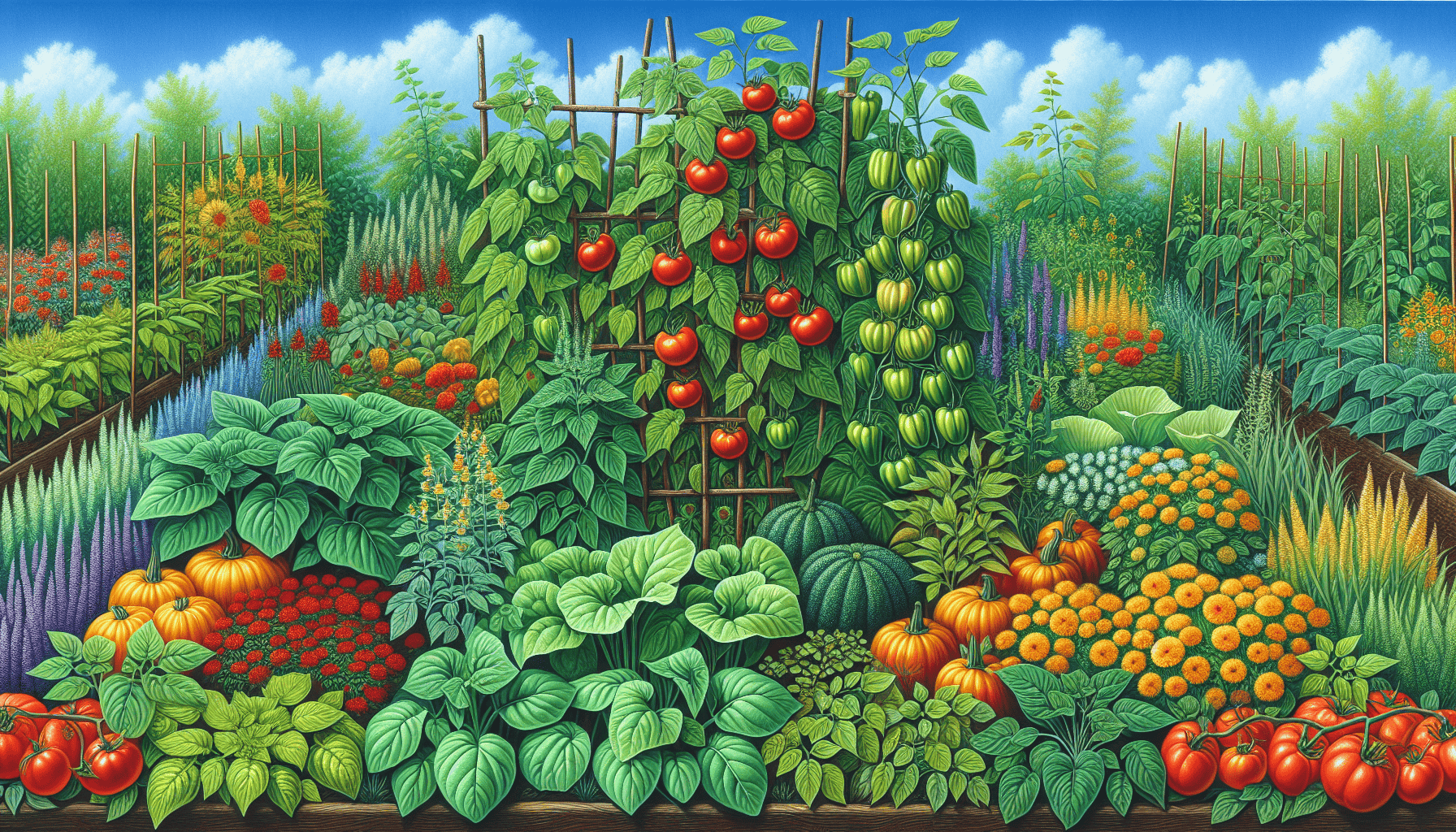
Companion planting is a time-honored technique that fuses ancient wisdom with contemporary, scientifically supported methods to cultivate a robust garden ecosystem. By thoughtfully co-locating diverse plant species, this approach bolsters growth, repels pests, and fosters healthier soil. Considerations for companion planting include the height of plants, their root systems’ depth, and their respective growth patterns to ensure mutually beneficial relationships among neighboring vegetation.
Imagine a vegetable garden where pole beans cast protective shade over lettuce plants below them, sheltering them from the scorching heat of summer days. This scenario exemplifies how companion planting operates effectively. A deeper appreciation of these innate plant interactions paves the way for developing both resilience and higher yields within your garden space.
What Is Companion Planting?
Companion planting is a strategy that maximizes garden efficiency by planting different species close together for mutual benefits. This practice involves growing one plant to help another, enhancing resilience and productivity. Some companion plants provide physical support to each other, reducing the need for staking or trellising and making the garden bed more manageable.
The essence of companion planting lies in understanding your garden as a system of biodiversity, where plants are interdependent. For example, certain crops can enhance each other’s growth by sharing nutrients and deterring pests, creating a balanced and thriving environment.
Benefits of Companion Planting
Companion planting offers a variety of advantages, which include:
Warding off pests in the garden and boosting its overall well-being.
Drawing in beneficial insects that target and consume harmful garden pests.
Minimizing reliance on chemical pesticides.
By carefully positioning specific tall plants together, you can foster a more sustainable and fruitful gardening environment.
Companion planting contributes to enhancing soil fertility by promoting natural nutrient enrichment within the soil ecosystem. For example, legume plants have the capability to fix nitrogen in the soil, thereby enriching it for subsequent crops’ growth. Also important, companion planting aids in controlling weeds since certain plant species are able to outgrow weeds for sunlight, water, and nutrients, which helps maintain an orderly and efficient vegetable garden.
Best Companion Plants for Vegetable Gardens
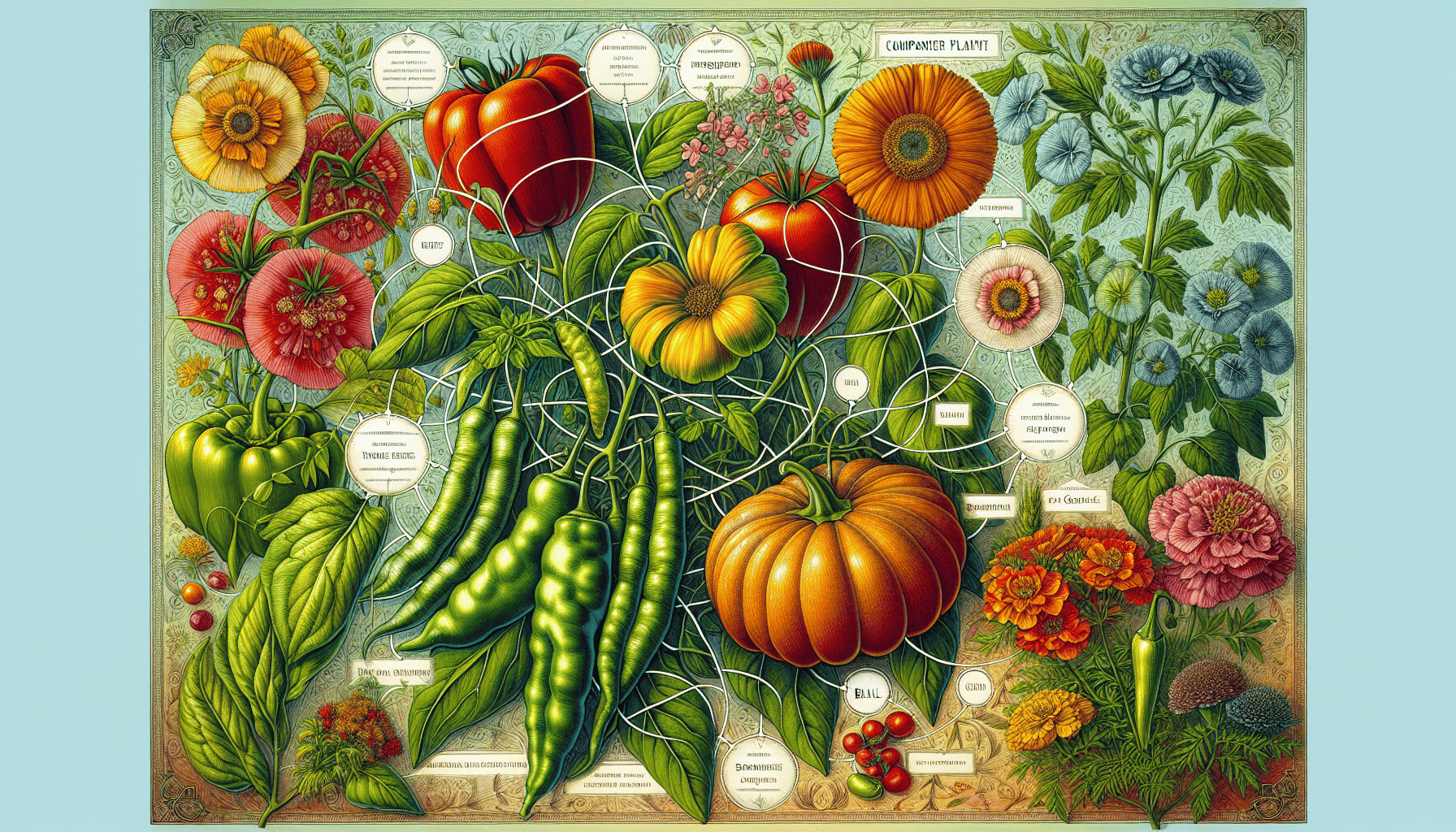
Understanding the synergistic relationships between different species is crucial when selecting companion plants for your vegetable garden. These beneficial plant pairings can optimize the use of space, enhance growth, deter pests, and increase crop production, thus making your gardening experience more fruitful.
Take the classic ‘three sisters’ planting method as an example: it involves sweet corn, squash plants, and beans growing together in mutual support. The forthcoming section will delve into some ideal companion plant choices for commonly grown vegetables to help you cultivate a productive and harmonious environment within your own garden bed.
Tomato Companion Plants
Pairing tomato plants with suitable companions in the garden can yield significant advantages, such as when tomatoes are grown alongside basil. Basil has been noted not only to improve the taste of tomatoes but also serves as a deterrent for pests including tomato hornworms. The symbiotic relationship formed by planting basil and tomatoes together fosters more robust plant health and enhanced production.
Carrots are recognized as favorable companion plants for tomatoes due to their prospering growth when situated nearby. Marigolds are another excellent choice. They ward off nematodes along with other harmful invaders. By integrating these beneficial plant companions into your garden bed, you provide an environment where your tomato plants can flourish vigorously and healthily.
Companion Plants for Peppers
Pepper plants can prosper significantly when grown alongside suitable companion plants. Basil and marjoram stand out as optimal partners due to their ability to deter insects, which protects the pepper plants from pest infestations. Onions serve as beneficial companions for peppers since they ward off carrot flies and aphids, promoting a more robust garden ecosystem.
It is critical not to place pepper plants in close proximity with specific crops that could impede their development. By meticulously choosing compatible plant partners while steering clear of unfavorable pairings, you can provide an environment where your pepper plants will thrive.
Green Bean Companion Plants
Green beans thrive when planted alongside compatible crops, making them ideal for intercropping practices. Corn, in particular, serves as an optimal companion to green beans due to its ability to enhance the nitrogen content within the soil, which is advantageous for both species. Bean varieties mutually benefit each other by fostering growth and enriching soil conditions.
Conversely, it’s important to steer clear of planting certain vegetables such as onions and beets near green beans since they can hinder their development. Choosing plants that harmonize well ensures a prosperous ecosystem for green beans along with various other crops.
Companion Planting with Herbs

In companion planting, herbs are essential for luring pests away, warding off harmful insects, and drawing in beneficial ones. Utilizing this organic pest control strategy fosters a varied and robust garden ecosystem that bolsters the development and yield of your vegetable plot.
Integrating herbs within your companion planting strategies can markedly amplify the hardiness of your garden. The following segment will delve into effective herb pairings and their ability to attract beneficial insects to your space.
Beneficial Herb Combinations
Choosing the right herb combinations can improve vegetable growth while also providing natural pest control. For instance, pairing onions with herbs like marjoram, savory, rosemary, and basil is beneficial as they help ward off pests and promote better onion development. Conversely, it’s crucial to steer clear of planting onions alongside asparagus, beans, sage, and peas because such pairings can impede the growth of onions.
By meticulously picking herbs that complement each other instead of those that have detrimental relationships with one another, ensures a garden space that thrives in both productivity and health.
Attracting Beneficial Insects with Herbs
Particular herbs excel in luring insects that are advantageous for controlling pest numbers. For example, hoverflies, which feed on aphids and serve as organic pest controllers, are drawn to poached egg plants. Lavender is also a prime selection. It repels pests yet draws pollinators.
For optimal results, let these herbs flower so that your vegetable garden maintains a consistent influx of beneficial insects. By employing this approach to naturally manage pests, you’ll foster a more fruitful and robust garden environment.
Flowers as Companion Plants

In the practice of companion planting, flowers are instrumental in bolstering soil health, warding off pests, and luring pollinators. Adding flowers to your garden not only elevates its aesthetic appeal, but also increases its yield and hardiness. Some specific flowers excel at repelling pests thanks to their distinctive aromas and hues, while others serve as magnets for advantageous pollinating insects.
We will delve into identifying which flowers can effectively deter unwanted insects and which can attract essential pollinators, along with offering guidance on how to incorporate these floral allies into your gardening strategy.
Flowers That Repel Pests
Annual and perennial plants can serve as a robust defense against garden pests. Petunias, for instance, are known to deter squash bugs and tomato hornworms, thus safeguarding your vegetables. Similarly, marigolds not only repel cabbage worms, but also draw in insects that feast on aphids—offering protection to the surrounding flora.
By emitting glucosinolates, nasturtiums form an essential part of your pest management strategy by keeping a range of unwanted invaders at bay. Positioning these blooms thoughtfully throughout your garden contributes to establishing an environment resistant to pests.
Flowers That Attract Pollinators
Certain flowers such as zinnias, sweet alyssum, daisies, sunflowers, and cosmos are highly effective in drawing pollinators. These vital insects substantially improve vegetable production by assisting with the process of pollination. Lavender also serves a dual purpose. It not only attracts these essential pollinators, but acts as a deterrent to pests.
Flowers that can attract valuable pollinators include:
Zinnias
Sweet Alyssum
Daisies
Sunflowers
Cosmos
The presence of these beneficial organisms is pivotal for augmenting vegetable crop yields through their role in the act of pollination. Lavender stands out uniquely as it both draws in important pollinating agents while simultaneously keeping undesirable pests at bay.
Encouraging your herbs to bloom can lead to an upsurge of advantageous insects which play an instrumental role in curbing pest populations and thus positively influencing the growth healthiness of vegetables. Integrate this variety of blooms into your garden space to foster an ecosystem replete with productivity and vibrancy.
Managing Garden Pests with Companion Planting
Utilizing companion planting can significantly bolster your defense against garden pests. By cultivating certain plants in proximity to one another, you not only minimize pest infestations, but also promote robust growth and benefit the surrounding wildlife. Employing this organic method of pest control is instrumental in maintaining a thriving and vigorous vegetable garden.
In this part, we will zero in on strategies for repelling prevalent pests as well as deploying trap crops that act as sacrifice plants to safeguard your prized produce. We’ll offer actionable advice on how to apply these techniques effectively.
Deterring Common Pests
Many companion plants serve as natural deterrents to usual garden pests. Marigolds, for instance, exude substances that ward off nematodes and a range of other nuisances in the soil. Similarly, nasturtiums release glucosinolates which act as repellents to different insects, thereby shielding vegetables such as broccoli.
To these flowering plants, herbs like chives can also repel problematic invaders including aphids and cabbage worms. By integrating these types of plants into your garden’s ecosystem, you create a protective barrier that naturally keeps vegetable crops safe from pest invasions.
Trap Crops
Employing trap crops is a potent method for controlling garden pests by luring them away from your prized produce. These fake plants attract unwanted visitors, mitigating harm to your key plants. An illustrative tactic includes sowing radishes alongside pumpkins as a means to deter squash bugs and shield the more precious pumpkin harvest.
The tactical placement of trap crops can markedly diminish pest-related destruction, bolstering the overall robustness of one’s vegetable garden.
Enhancing Soil Health Through Companion Planting
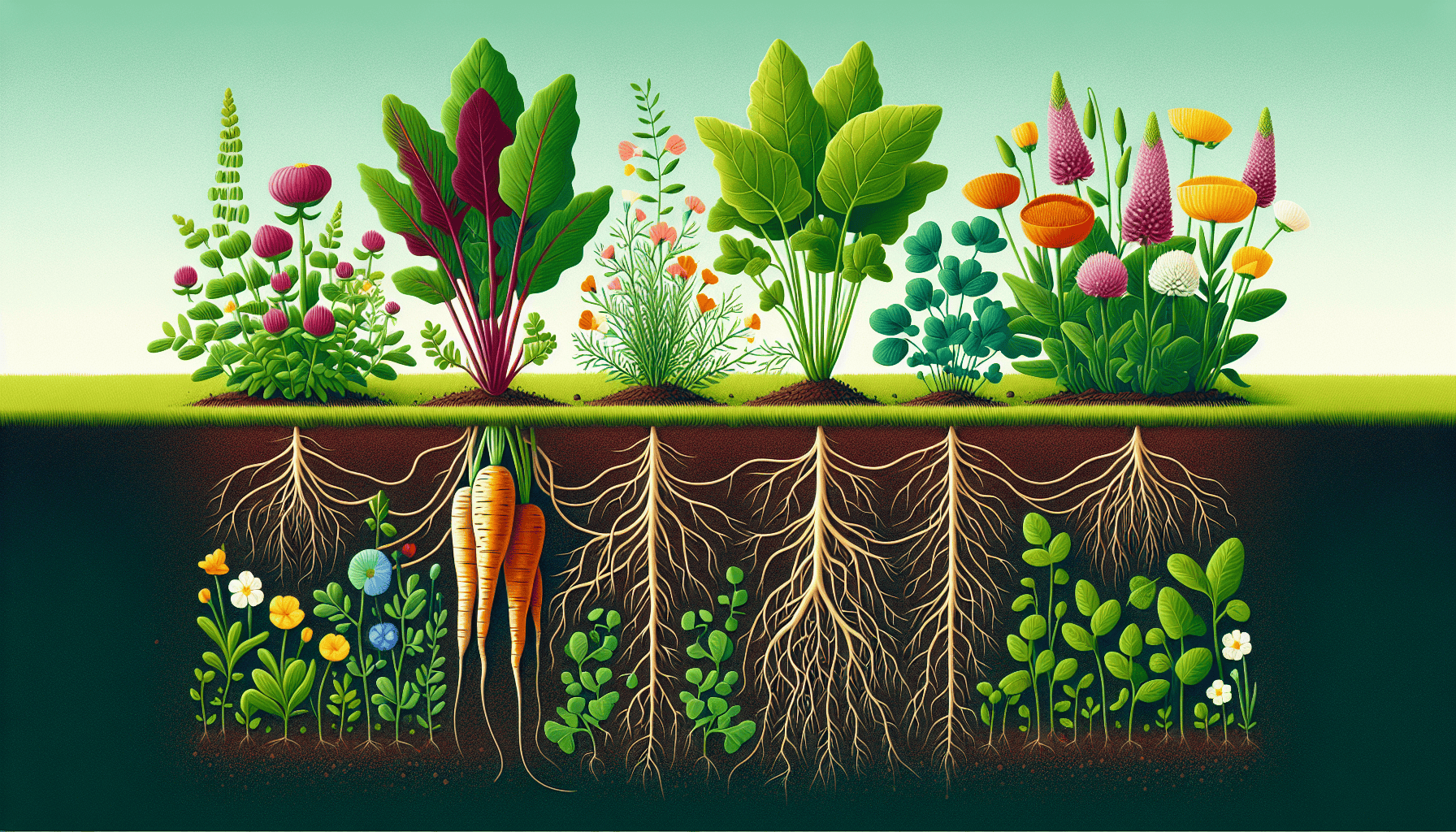
Incorporating companion plants into your garden not only aids in pest control but also markedly boosts the health of your soil. The inclusion of different root systems from these companion plants can improve the texture of the soil and increase nutrients. Such variety fosters more vigorous gardens, encouraging enhanced water absorption and deeper root growth.
Engaging in companion planting bolsters varied microbial activities that are crucial for recycling nutrients and maintaining fertile soil. In this segment, we’ll delve into how crops with deep roots along with nitrogen-fixing flora play a vital role in preserving robust soil conditions.
Deep Rooted Crops
Crops with deep roots can reach the nutrients found in deeper soil strata, which benefits neighboring plants by making these nutrients more accessible. They also help to loosen dense soil layers, thus improving both the composition of the soil and its capacity for air flow. The channels formed by their roots aid in better water absorption and facilitate deeper root growth from other plants.
By including crops like carrots and parsnips that have long roots into your strategies for companion planting, you can foster a more vigorous and fruitful garden. These types of crops promote improved nutrient dynamics as well as stronger structural conditions within the soil—key aspects that contribute to a flourishing vegetable garden.
Nitrogen-Fixing Plants
Leguminous plants, including various beans and peas, are vital for increasing soil fertility. They possess root nodules that transform atmospheric nitrogen into a form accessible to other plants, thereby enriching the soil. This biological mechanism diminishes reliance on synthetic fertilizers, promoting sustainability in your garden.
By integrating crops such as peas and beans with additional vegetables through companion planting practices, you enhance the nitrogen content of the soil, which in turn amplifies the productivity of your entire garden. The adoption of these methods will result in more robust soil health and improved harvest outcomes.
Maximizing Space and Yield in Your Garden
To ensure your gardening is as efficient as possible, it’s crucial to make the most of both the space and the yield of your garden. Employing companion planting techniques such as interplanting alongside crop rotation can lead to a considerable reduction in necessary growing space while boosting overall productivity. By cultivating diverse plant species within one shared zone, you not only achieve elevated yields but also a more effective utilization of available space.
We will delve into methods for interplanting and discuss how rotating crops offers advantages that aid in optimizing both the spatial dynamics and productive capacity of your vegetable garden, offering actionable advice along the way.
Interplanting Strategies
Incorporating diverse crops in close proximity within a garden bed, known as interplanting, serves to optimize the usage of space and enhance the vitality of plants. An effective pairing is seen when onions, carrots, and lettuce share a plot because they have varying requirements for root space and sunlight exposure. Conversely, it’s advised to avoid planting zucchini alongside tomatoes or corn as these combinations can lead to resource competition regarding nutrients and physical space.
When establishing a harmonious garden bed through interplanting methods, placing suitable plants about 9 inches from each other ensures both productivity and spatial efficiency. Employing such strategies elevates the overall output potential of your gardening area.
Crop Rotation and Companion Planting
Implementing crop rotation is vital to preserve soil health and avert the accumulation of pests and diseases. By frequently alternating the placement of different crop families, you not only curb soil exhaustion, but also boost its fertility. This method hinders pest and disease proliferation in your garden’s earth, enhancing its robustness.
When integrated with companion planting practices, such an approach can significantly enhance the vitality and yield of your vegetable garden. Recognizing synergies between various plants while strategically rotating them optimizes soil health and amplifies produce output from your gardening efforts.
Creating a Companion Planting Chart
Constructing a companion planting chart is an essential resource for gardeners. It serves as a quick reference to arrange companion plants effectively, aiding in choosing the best pairings that enhance plant vigor and productivity. By streamlining the identification of compatible plant relationships, such a chart improves gardening efficiency.
Leveraging tools such as the Almanac Garden Planner enables you to effortlessly discover ideal combinations and cultivate a flourishing garden bed. This segment will navigate you through developing your personal companion planting chart.
Step-by-Step Chart Creation
In the creation of a companion planting chart, it’s crucial to consider the particular flowering periods and light requirements of each plant. For example, positioning marigolds in front of tomatoes guarantees that they are exposed to ample sunlight while maintaining their visibility. This guide provides you with a systematic approach for constructing a chart aimed at optimizing your garden’s performance.
Arranging your flora according to how well they grow together can boost both growth and yield in your gardening space. Such an instrumental resource simplifies the process of companion planting, making it more user-friendly for novice and experienced gardeners alike.
Example Chart
A companion planting chart suggests pairing tomatoes with a variety of plants such as basil, marigolds, asparagus, carrots, celery, members of the onion family, lettuce, parsley and spinach for an optimal garden bed. The combination of tomatoes and basil is known to improve both growth and taste. Marigolds serve to repel nematodes and other pests.
By adhering to these plant pairings from the companion chart in your garden bed setup can result in stronger plants and increased crop production. Such strategic planting will enhance the fruitfulness of your gardening endeavors.
Summary
In summary, by embracing companion planting and its multitude of advantages—such as enhanced growth, effective pest control, and better soil health—you can significantly boost the vitality and yield of your vegetable garden. Grasping the inherent synergies among plants and applying the techniques mentioned will lead to a robust and prosperous garden. Adopt these companion planting fundamentals for a flourishing display of health and abundance in your garden.
Frequently Asked Questions
What are the benefits of companion planting?
Employing the technique of companion planting can elevate your garden’s performance by promoting growth, deterring pests, improving soil health, and optimizing overall productivity.
Adopt this approach to cultivate a vibrant and balanced ecosystem within your garden!
Which herbs are good companion plants for vegetables?
Incorporating herbs such as basil, marjoram, rosemary, and savory amongst your vegetable plants can be highly beneficial. They serve as excellent companion plants by deterring pests and promoting growth.
Utilize these aromatic herbs to improve both the vigor and yield of your garden!
How do flowers contribute to companion planting?
Incorporating flowers into your garden plays a pivotal role in companion planting because they not only deter pests but also attract helpful pollinators and contribute to the improvement of soil health. By adding them to your garden, you can increase both its productivity and resilience, thereby making your gardening endeavors all the more fruitful!
What are trap crops, and how do they work?
By employing trap crops as sacrificial plants strategically placed to lure pests away, you can safeguard the well-being of your treasured vegetation and significantly reduce harm to your garden!
How can I create a companion planting chart?
Begin constructing a companion planting chart by utilizing tools such as the Almanac Garden Planner, which aids in pinpointing plant combinations that promote better growth and increased resistance to pests.
By doing so, you can arrange your garden more efficiently, thereby greatly improving your chances of successful gardening!

